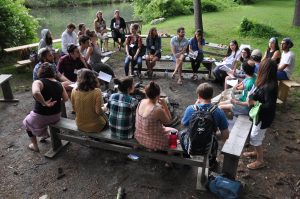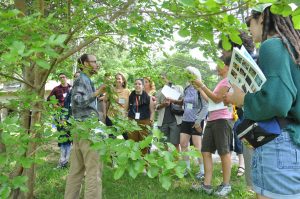One of the many privileges of having served as Executive Director of the Jim Joseph Foundation has been ample opportunity to contribute to the field of Jewish education. In personal conversations; at convenings, forums and conferences; through the Foundation’s website and on this blog; and in various publications, I have shared information on lessons learned by the Foundation through its $436 million of philanthropic investments. I have also opined on trends in the broader fields of education and philanthropy, all in an effort to advance the field about which the Foundation and readers of this blog care so deeply.
Over the next two months, as I step down from the position in which I have been privileged to serve, I want to make maximum use of this platform by highlighting three themes which have emerged as integral to the Foundation’s work. Each of the three blogs will offer reflections in the context of the more than twenty years of study and experience I have had participating in philanthropy to support education.
In this first blog, I discuss the benefits of a concentrated set of priority grants. In this regard, the Foundation’s evolution has resulted in a relatively limited number of major grants of very significant grant amounts over longer periods of time than are customarily awarded.
Before the Foundation began its grantmaking in 2006, the Board undertook an accelerated strategic planning process that included commissioning ten papers from established communal thought leaders as well as a landscape analysis of the field of Jewish education, led by Brandeis University professor Dr. Amy Sales. I do not recall that the Foundation set a target for the number of grants Directors anticipated they would grant on an annual basis, nor did they establish policy that stipulated amounts or duration of grant awards. Board members did make clear, however, that they wanted to honor Jim Joseph’s memory by building a legacy befitting his generosity and that, over the years, the Foundation could convincingly demonstrate philanthropic effectiveness.
Directors early on showed a determined willingness to test the hypothesis that fewer (grants awarded), greater (amounts of funding), and more (years of support) could provide results. This approach derived from the following set of key realizations and decisions the Foundation made regarding how to best pursue its mission:
- Some organizations and institutions are better aligned with the Jim Joseph Foundation mission and strategic priorities than others.
- Given the Foundation’s vision of “ever increasing numbers of young Jews engaged in ongoing Jewish learning and choosing to live vibrant Jewish lives,” the potential for greater growth and scale in the number of young Jews served became a critically important criteria for grant consideration.
- Rigorous due diligence conducted by Foundation professionals on grant applications and budgets consistently revealed inadequate resources in operations, technology, evaluation, professional development, financial reserves and other functional areas of budget. This indicated a need for significant infusion of financial capital.
- Grantee achievement of target grant objectives and goals of a Jewish educational nature take time, especially if such progress is to be assessed in reliable, valid ways.
- Related to # 4 above, the Foundation conceptualized its philanthropy to involve continuous discovery, assuming that relationships with grantees developed over time would be most conducive to “grounded” learning.
So the Foundation from the outset accepted the proposition that if grantees’ demonstrated success would be a key measure of the Foundation’s effectiveness, then it would consider multi-year grants and potential renewal of them. Now, almost eleven years into its grantmaking, the facts are these: the average length of time of an award to a major grantee ($1M or more) is 4.1 years. 61% of these major grantees have received renewal grants and 33 grantees have received $378M of the $436M awarded by the Foundation.
Certainly, the Jim Joseph Foundation is not unique as a foundation in directing significant resources for multiple years to mission-aligned grantees. In the field generally, a good deal of what is called “social venture” and “high engagement” philanthropy feature long term commitments of funding as a staple of the style. For example, Christine Letts and William Ryan, in a study of six funders conducted in 2003, found that the foundations “funded their grantees for an average of seven years and many anticipated continuing their funding indefinitely” (Ryan, William & Letts, Christine. “Filling the Performance Gap: High Engagement Philanthropy. What grantees say about power, performance and money.” Stanford Social Innovation Review, Spring 2003: pg. 29). In this month’s issue of The Chronicle of Philanthropy, Elspeth Revere, former MacArthur Foundation Vice President for Media, Culture and Special Initiatives, avers that grant award durations should be “as long as possible. Three to five years should be the norm, but why not make 10-year grants to organizations that have proven their effectiveness?” (Revere, Elspeth. “After 25 Years of Grant Making, I Worry We Have Lost Sight of Nonprofit Struggles.” The Chronicle of Philanthropy, Sept. 2016: pg. 31).
The Jim Joseph Foundation essentially started with a blank slate in 2006. It could have chosen any number of approaches to its grantmaking. In retrospect, I think one of the most important patterns Directors established was to ask professional staff to bring to the Board major grant proposals from highly aligned grantee seekers that sought significant, long-term funding. The Foundation expected that its large investments would be accompanied by careful grant monitoring and evaluation. The dynamic that originally unfolded led to Foundation and grantee personnel forming close and trusting relationships with one another (about which I will write more in my next blog). Moreover, the Foundation providing renewal funding to its high performing grantees often engendered deepened relationships with these grantees and frequently stimulated other funders to seek Jim Joseph Foundation intelligence on, and experience with, a number of its grantees organizations. Co-funding and collaborative grantmaking ultimately emerged from these conversations.
The Foundation has learned in its first eleven years that multi-million dollar grants given to a relatively small numbers of organizations, renewed on a performance basis, offer distinct benefits to the field of Jewish education, including:
- effective grant implementation that—thanks to approximately 100 independent, professional evaluations—evidence greater numbers of young Jews engaged in meaningful, substantive Jewish learning;
- two dozen Jewish organizations with improved programs and systems offering more young Jews richer Jewish educational experiences than was previously the case; and
- an array of funders of Jewish education directly engaging one another as thought partners in their shared interest to build the field.
All of these positive outcomes affirm my belief that “foundations would likely be more effective if they…saw themselves as long-term strategic partners solving mutually important problems…” (Bacchetti, Ray. Ehrlich, Thomas. Reconnecting Education & Foundations: Turning Good Intentions into Educational Capital. The Carnegie Foundation for the Advancement of Teaching. 2007. Pg. 76).
I am grateful to have served a Board of Directors that believes in and actively seeks to realize the Foundation’s vision. Of course, both the Board and professional team are fortunate to work with many high performing grantee partners. Together, we have endeavored to make the most of eleven years of exceptional philanthropic opportunity.

 As the Jim Joseph Foundation has discussed, collaboration comes with real challenges. Yet time and again we see that the benefits—creative initiatives; greater reach; more opportunities to scale and to become sustainable—outweigh these challenges. It is not unlike a basketball team where superstars come together, perhaps giving up solo fame and the chance to each score more, for the singular focus of winning a championship, which everyone on the Warriors wants to accomplish again, especially after a particularly disappointing Game 7 loss on June 19th (yes, I remember the date). The recruitment of Kevin Durant was not a singular coach speaking with a player. Amidst many dealmakers on both sides of the negotiation table, four long-tenured Warriors were all a part of the process and the effort to recruit Durant. Each of them knew that bringing him to the Bay Area would greatly increase their chances at another championship season while as a counter-point acknowledging that bringing this addition would likely reduce the shot attempts and general production value of several if not all of these four players.
As the Jim Joseph Foundation has discussed, collaboration comes with real challenges. Yet time and again we see that the benefits—creative initiatives; greater reach; more opportunities to scale and to become sustainable—outweigh these challenges. It is not unlike a basketball team where superstars come together, perhaps giving up solo fame and the chance to each score more, for the singular focus of winning a championship, which everyone on the Warriors wants to accomplish again, especially after a particularly disappointing Game 7 loss on June 19th (yes, I remember the date). The recruitment of Kevin Durant was not a singular coach speaking with a player. Amidst many dealmakers on both sides of the negotiation table, four long-tenured Warriors were all a part of the process and the effort to recruit Durant. Each of them knew that bringing him to the Bay Area would greatly increase their chances at another championship season while as a counter-point acknowledging that bringing this addition would likely reduce the shot attempts and general production value of several if not all of these four players.
 A couple of years ago, four foundations set out to find the answer to a critically important question: How do we measure the success of our Jewish teen engagement and education initiatives?
A couple of years ago, four foundations set out to find the answer to a critically important question: How do we measure the success of our Jewish teen engagement and education initiatives? In San Francisco, the school year is about to end. Teachers and children (mine included!) are counting down the final days to summer. In the Jewish calendar, we are counting, too, but upwards rather than down as we mark the days of the Omer.
In San Francisco, the school year is about to end. Teachers and children (mine included!) are counting down the final days to summer. In the Jewish calendar, we are counting, too, but upwards rather than down as we mark the days of the Omer. Today’s young adults possess passion and energy in abundance. They are ambitious, smart, creative, and driven by a desire to help others. They know how to bring new technologies and networks of peers to bear on the hard work of community building. They are dreamers and doers in equal measure.
Today’s young adults possess passion and energy in abundance. They are ambitious, smart, creative, and driven by a desire to help others. They know how to bring new technologies and networks of peers to bear on the hard work of community building. They are dreamers and doers in equal measure.